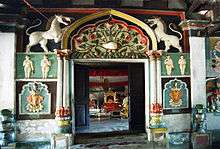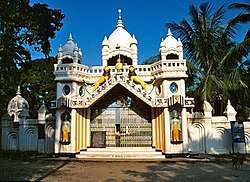Satra (Ekasarana Dharma)
Satras (Assamese: সত্ৰ) are institutional centers associated with the Ekasarana tradition of Vaishnavism, largely found in the Indian state of Assam and neighboring regions.[1][2] Numbering in the hundreds, these centers are generally independent of each other and under the control of individual adhikaras (or satradhikars), though they can be grouped into four different Sanghatis (orders).

These centers, in the minimum, maintain a prayer house (Namghar, or Kirtan-ghar), initiate lay people into the Ekasarana tradition and include them as disciples of the Satra from whom taxes and other religious duties are extracted. Although the culture of setting up religious institutions like Satras started in Sadiya, the Neo-Vaishnavite satra culture started in the 16th century. They grew rapidly in the 17th century and patronage extended to them by first the Koch kingdom and later the Ahom kingdom was crucial in the spread the Ekasarana religion.[3] Many of the larger Satras house hundreds of celibate and non-celibate bhakats (monks), hold vast lands and are repositories of religious and cultural relics and artifacts. The Satras extend control over their lay disciples via village Namghars. Satras in which the principal preceptors lived, or which preserve some of their relics are also called thaans.[4]
The first Satra in Assam was established by a Brahmin priest named Sankarisan in Sadiya under the patronage of the Chutia king Ratnadhwajpal at the start of the 13th century. It was named Ghaimora and later came to be known as Gharmora Satra.[5]Another satra was established by a king named Samudrapal at a place known as Yogihati in the same period(1232 AD) as evident from a stone inscription found in Ambari.[6] The neo-Vaishnavite satras were established by Assamese Vaishnavite monasteries for religious practices at the initiative of the Ahom Kings of Assam in the middle of the 17th century[7] to propagate neo Vaishnavism.[8][9] Sankaradeva is said to have established his first Satra at Bardowa, his birthplace, and then in different places of Assam.[10][11][12]
In the 20th century the authority and orthodoxy of the Satras was challenged by reform movements, most notable under the Sankar Sangha. The Satras coordinate some of their activities via the Asam Satra Mahasabha, an umbrella organization of all the Satras. According to the Mahasabha's count on its website there is altogether a total of 862 Satras including the satras present in both the states of Assam and West Bengal.[13]
Structures
The Satra is generally a four-sided enclosed area with four gateways (karapat). Centrally placed in this enclosure is a rectangular prayer-hall (Namghar or kirtanghar) at the aligned in the east-west direction. On its eastern side there is an additional independent structure called the Manikut (jewel-house), the sanctum santorum, in which the asana, a wooden tetradehral structure with four carved lions), is placed containing the main object of worship (usually a copy of the Bhagavat Purana in manuscript or an idol). The namghar is surrounded by four straight rows of huts, called hati, in which monks (bhakats) reside. The adhikara and other high officers of the Satra reside in the eastern hatis.[14]
All structures were originally temporary, made with wood, bamboo and covered over with thatch; brick and mortar found use after the 18th century.[15]
Monks, called bhakats, live in satras under a satradhikar or Mahanta. In some orders of the religion, the bhakats are celibate (kewalia bhakat). The satras are not merely religious institutions but play cultural and historical roles in society. A dance form that was initiated by Srimanta Sankardeva and later developed within the sattras, and thus called Sattriya, is one of the eight classical dance forms in India.
Origin and evolution
The name satra originates in the Bhagavata Purana in Sanskrit (sattra), and is used in the sense of an assembly of devotees.[16] During Sankardev's lifetime, the devotees assembled in the open, under trees. Though temporary prayer houses were built, the tradition of devotees living in the premises did not happen during Sankardev's lifetime. The first mention of the hati is found in the context of the Patbausi Satra of Damodardev. Madhavdev built the Barpeta Satra, and laid down the system of daily prayer service and initiated the system of religious tithes. Vamsigopaldev was instrumental in establishing Satras in eastern Assam. Though the Ahom kingdom initially resisted the ingress of religious preceptors it finally endorsed the Satras enabling them to establish themselves on sound economics, make themselves attractive to the lay people and spread the Ekasarana religion. Soon Majuli, in eastern Assam, became a center of Satra tradition and authority.
Cultural programmes
Some of the cultural programmes, which are held in Sattras:
- Bhaona
- Doul Utsav or Deul
- Janmastami
- Rasa lila or Raas utsav
Photo gallery
 Sankardev Satra of Patbausi, Barpeta
Sankardev Satra of Patbausi, Barpeta- Sotai Satra
See also
Notes
- S. M. Dubey (1978). North East India: A Sociological Study. Concept. pp. 189–193. Archived from the original on 3 January 2020. Retrieved 13 October 2016.
- Sarma 1966.
- (Sarma 1966, pp. 23–24)
- (Sarma 1966, p. 101)
- Dr. Swarnalata Baruah(2004), Chutiya Jaatir Buranji, Page 335, Gharmora Satra
- "The inscription has recorded that Samudrapala who was like the Sun God had this sattra establishment within his jurisdiction, in which rituals were performed and was attached to the royal residence, the inmates o f the sattra being the yogis or siddhas, residing at a particular spot called YogihatT. The inscription is dated Saka 1154 (A.D. 1232) and was composed by one Mudha." (PDF). Archived (PDF) from the original on 11 June 2020. Retrieved 25 May 2020.
- "Sri Sri Auniati Satra:". Auniati.org. Archived from the original on 2 June 2015. Retrieved 28 March 2013.
- "SATRA". Vedanti.com. Archived from the original on 4 March 2016. Retrieved 28 March 2013.
- "Satras". OnlineSivasagar.com. Archived from the original on 29 December 2014. Retrieved 28 March 2013.
- "The Sentinel". Sentinelassam.com. Archived from the original on 24 September 2015. Retrieved 28 March 2013.
- "Temples & Legends Of Assam.Satras-III -(page1)". Hindubooks.org. Archived from the original on 27 December 2014. Retrieved 28 March 2013.
- History of Education in Assam. Mittal Publications. pp. 4–. GGKEY:CPYTFZEK94F. Archived from the original on 18 June 2013. Retrieved 29 March 2013.
- Correspondent (12 October 2009). "Satra Mahasabha renews demand for separate directorate". The Assam Tribune. Archived from the original on 7 May 2013. Retrieved 7 May 2013.
- (Neog 1980, p. 309)
- (Neog 1980, p. 313)
- (Neog 1980, p. 310)
References
- Neog, Maheshwar (1980). Early History of the Vaishnava Faith and Movement in Assam. Delhi: Motilal Banarasidass.CS1 maint: ref=harv (link)
- Nath, S N (2012). SATRA SOCIETY AND CULTURE, Pitambardeva Goswami and History of Garamur Satra. DVS Publisher. ISBN 978-81-86307-56-4. Archived from the original on 17 October 2013.
- Sarma, S N (1966). The Neo-Vaisnavite Movement and the Satra Institution of Assam. Gauhati University. ISBN 978-8173310263.CS1 maint: ref=harv (link)
External links
| Wikimedia Commons has media related to Satra. |
- A view of a Satra in Majuli, Assam, India on YouTube
- A Tribute to Sankaradeva - A website on the Neo-Vaisnavite Movement of Srimanta Sankardeva
- Bhakti Movement in the Brahmaputra Valley: Response of the Satra Institution towards Social Equality